Six Powerhouse Native Grasses
AS WE HEAD INTO SUMMER and wave goodbye to all the bright-colored spring blooms we’ll be losing from our gardens, we should give a nod to grasses. If you’re like most of us, you grew up using “grass” to refer to that matted lawn you’d run across when someone turned on the sprinkler. You seldom if ever heard the term “grasses” to refer to all the amazing ornamental grasses that keep on keeping on all summer long. Some are big and add drama, others are soft and bring romance to the garden.
There are a lot of non-native grasses available at your local garden center, but don’t overlook some of our beautiful and ecologically important North American native grasses. We picked the cream of the crop – powerhouse grasses that are native far and wide across the U.S. and have great garden appeal.
Little bluestem (Schizachyrium scoparium)
This grass hits its stride in August when slender, blue-green stems appear, reaching 3 feet by September. By fall, they’ll turn a stunning bronze that will last all winter. It’ll tolerate sun or part shade, but readily seeds, so avoid it if your garden is small. Little bluestem is a larval host for skipper butterflies and provides nesting material for birds. Native plant gardeners rejoice! It is native to more than half of the country. See if it works for you.
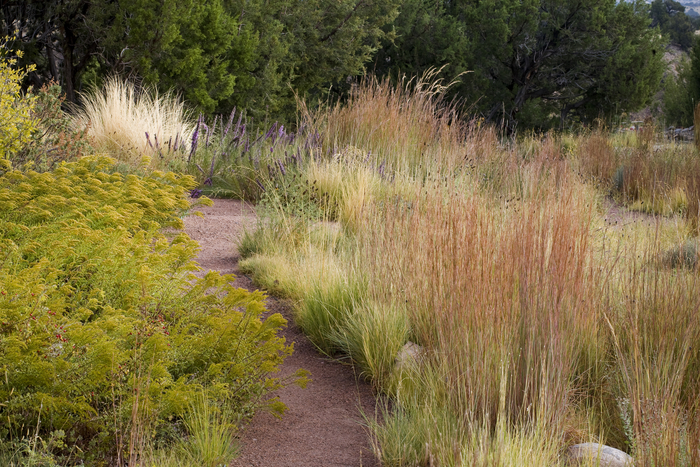
Path through drought-tolerant meadow garden with little bluestem, dwarf goldenrod and juniper hedge in Albuquerque, New Mexico. PHOTO Saxon Holt
Indian grass (Sorghastrum nutans)
All types of livestock love this grass, which makes it one of the most critical grasses of the tallgrass prairie – that once covered 1/3 of North America from Canada to Texas. In the garden, Indian grass appeals to other senses and makes a stunning accent plant. Many know it for its height – up to 8 feet – and foot-long, plume-like seedhead. That golden crown contrasts nicely with blue-green stems when it begins to bloom in August. Later on, it adds rich reddish fall color to the garden. Native all the way from Quebec to Florida then west to Arizona and south into Mexico.
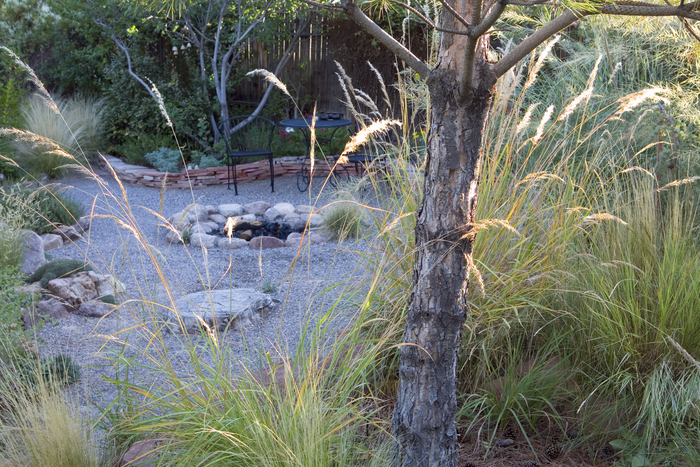
Firepit in secluded garden room in back yard meadow garden with Black pine tree and flowering Indian grass (Sorghastrum nutans) and Nassella in Albuquerque. PHOTO Saxon Holt
Prairie dropseed (Sporobolus heterolepis)
Large round tufts formed by leaves that curve outward make this a great accent plant. In summer, it puts on an even better show when delicate seedheads extend 2 feet above the tuft. Don’t let its fresh green appearance fool you, prairie dropseed likes it dry and can stand the heat, making it a great choice for a lush, xeric garden. Many gardeners like to plant it en masse alongside a path or border with taller perennials such as purple coneflower (Echinacea spp.) rising above it for a cottage-garden look. Although you might not think of grasses offering a scent, the blooms of this grass smell like buttered popcorn.
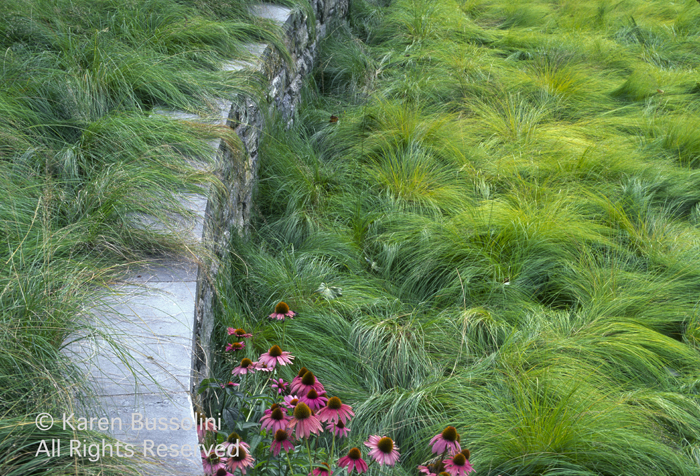
Prairie dropseed (Sporobolus heterolepis), shown here at Chanticleer Garden in Wayne, Pennsylvania, has an irresistible fine texture, forms low mounds and sends up taller flower stalks with panicles of delicate blooms.
Switchgrass (Panicum virgatum)
An ornamental with a shockingly wide native range, switchgrass is another staple of the tallgrass prairie. The large, purple-red seedheads of this clump grass begin blooming in August, and its stems turn yellow, burgundy or other colors in fall. Switchgrass has lent soft movement to many a formal native garden. It’ll take dry or wet, but prefers some water and sun or part shade.
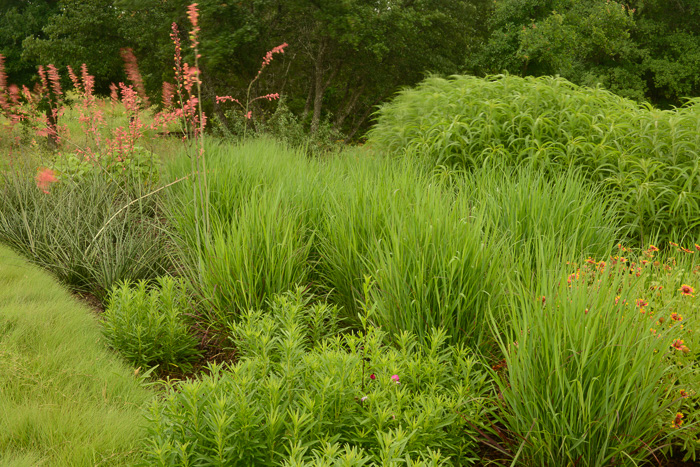
Switchgrass (Panicum virgatum) looking great at the Wildflower Center’s Family Garden after this spring’s long stretch of welcome rain. Also shown is red yucca at left (Hesperaloe parviflora), Maximillian sunflower (Helianthus maximiliani) at back, and a lawn of Buffalograss (Bouteloua dactyloides). PHOTO Wildflower Center
Inland sea oats (Chasmanthium latifolium)
Summer is the time for this striking grass to shine. Inland sea oats is distinguished by its large, elegant seedheads that resemble oats and dangle from arching branches. Seedheads can stay on from June through January for native gardeners from Pennsylvania west to Kansas to enjoy. This grass is ideal for that shady spot where you can spare some water. Pluck seed stalks to enjoy in arrangements.
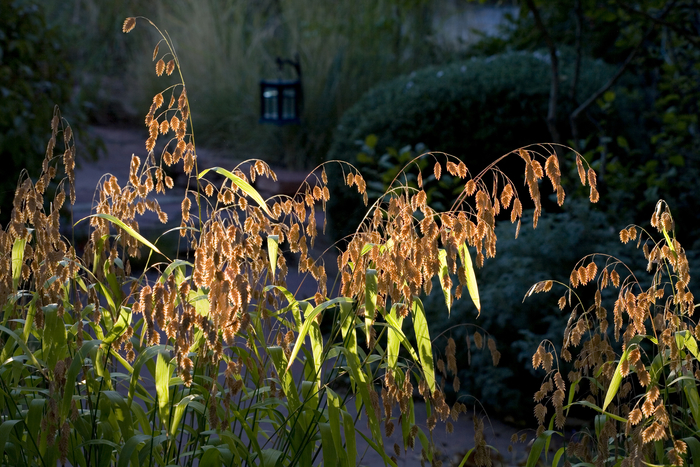
Inland sea oats (Chasmanthium latifolium) in an Albuquerque meadow garden. PHOTO Saxon Holt
Blue grama (Bouteloua gracilis)
Not to be overlooked is blue grama grass, which is among the shortest of our native ornamental grasses even when in full flower. It doesn’t get taller than 14 inches, but good things come in small packages. This one seems to withstand it all: drought, cold and heat. Its drought-tolerance has made many a landscaper replace their exotic lawn with it; it tolerates drought even better than buffalograss (another native). Blue grama’s eyelash-shaped seed heads shimmer atop tufted foliage, setting this grass apart as a compliment to other diminutive plants in the garden.
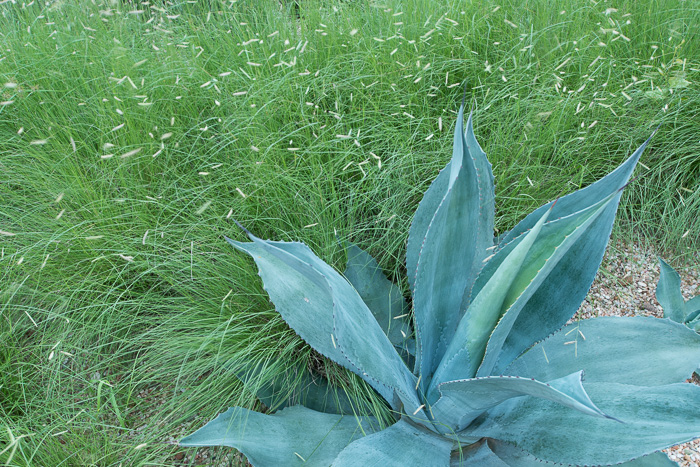
Blue grama grass (Bouteloua gracilis) is easily recognized by its horizontal seed heads. Designers love to plant it en masse for a polished, dramatic display. In the Wildflower Center’s Family Garden, it envelopes a curved wall (top) and contrast with a striking agave (bottom).
Written with Lee Clippard

